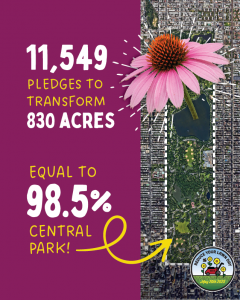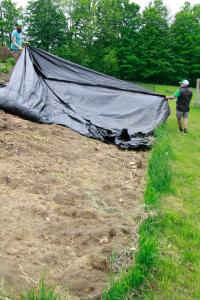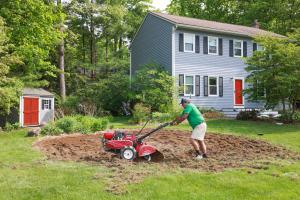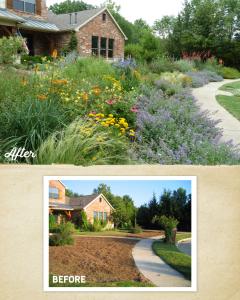National 'Reduce Your Lawn Day' Movement Converts 36 Million Square Feet of Turf to Pollinator-Friendly Landscapes

This Gold Laurel Award from GardenComm celebrates the collective effort behind Reduce Your Lawn Day initiative—11,500 pledges and 36M sq ft of lawn transformed in it's second year.

In its second year, over 11,500 participants pledged to convert 36 million sq. ft. of turf to sustainable alternatives for Reduce Your Lawn Day—nearly the size of NYC’s Central Park. A testament to the power of collective action.

Fall smothering is a low-effort way to prep your yard—let time and nature do the work now for easier planting in spring.
Fall Marks an Ideal Time for Homeowners to Prepare Lawns for Wildflowers, Groundcovers, and Sustainable Gardens
A MOVEMENT, NOT JUST A DAY
Reduce Your Lawn Day was created to ignite a movement—not just start a conversation. While the annual day serves as a rallying point, the initiative is a year-round effort that encourages homeowners, gardeners, and communities to rethink traditional landscapes, improve environmental impact, and take tangible steps toward climate resilience and biodiversity.
"Fall is one of the best times to rethink a yard," said Tabar Gifford, Master Gardener and Partnership Cultivator at American Meadows. "Reduce Your Lawn Day isn’t just about a single day — it’s about creating pollinator-friendly, sustainable landscapes season after season, one patch at a time.
COLLECTIVE ACTIONS ADD UP: SUSTAINABLE YARD SOLUTIONS
Across thousands of households, small local actions are adding up to create a measurable national impact. Replacing sections of turf with native wildflowers, flowering lawns, groundcovers, and climate-adapted plants helps form pollinator corridors, improves soil health, reduces water use, and restores habitat.
Fall is an ideal season to prepare for sustainable landscaping. Cooler temperatures, increased rainfall, and lower weed pressure make planting and site prep easier. Whether sowing wildflowers, establishing a flowering lawn, or prepping garden beds, fall efforts set up success for the following spring.
AN AWARD-WINNING NATIONAL EFFORT – ONE PATCH AT A TIME
Now in its second year, the Reduce Your Lawn Day movement has reached a major milestone with 36 million square feet pledged for conversion—earning the GardenComm Gold Laurel Award in recognition of its collaborative success. Engagement continues to increase as communities nationwide prepare their landscapes for fall planting and next year’s growth.
WHY FALL IS THE PERFECT TIME TO ACT
Cooler temperatures, increased rainfall, and lower weed pressure make fall an ideal season for preparing landscapes for the following year. Planting or site preparation in this season requires less watering, promotes stronger root establishment, and reduces weed pressure in spring. Whether sowing wildflowers, establishing a flowering lawn, or prepping garden beds for spring, laying groundwork in fall sets up long-term success.
HOW HOMEOWNERS AND COMMUNITIES CAN PARTICIPATE
Homeowners and community groups interested in joining the movement can take the following steps this fall:
1. Assess the Site
Identify areas of lawn for conversion, evaluating sunlight, soil, and water conditions. Consider where changes can be made and how much lawn will be replaced. Start small or plan a larger project—every patch matters.
"Groundcovers are often better choices than turfgrass lawns in situations where a grass lawn struggles to grow—such as in deep shade, too wet, too dry, on a steep slope, in poor soils, or under intense sun/heat," said Kathy Jentz, author of Groundcover Revolution and co-founder of Reduce Your Lawn Day. "Native groundcovers can also be chosen that adapt better to local conditions."
2. Plan Planting Timing
Many native wildflowers thrive when sown in fall, while other projects may benefit from site preparation now and planting in early spring. Reserving seeds or plants early helps ensure availability and the best selection.
3. Prepare the Area
Select a method that aligns with the project timeline and goals:
• Smother and Tarp: Cover turf with tarps or black plastic to allow natural breakdown over winter. Performing this process in fall reduces the intensity of spring prep work and creates optimal conditions for planting.
• Lasagna Smother: Layer cardboard, compost, and mulch to suppress grass while simultaneously improving soil health. This method builds nutrient-rich soil and prepares the area for planting in the next growing season.
• Cover Crop: Sow cover crops to enhance soil fertility, prevent erosion, and suppress weeds before spring planting. A winter cover crop can enrich soil further and maintain control over areas designated for sustainable plantings.
4. Engage Neighbors and Communities
Community planting days or fall site prep events help spread the movement and encourage participation in sustainable landscaping.
5. Evaluate and Share Progress
Households and groups that have reduced lawn area are encouraged to document transformations, share before-and-after photos, and swap ideas to inspire others.
END-OF-SEASON MEADOW MAINTENANCE: KEY TIPS
For those who planted a meadow this spring, the most common question is: What comes next?
Mowing: Wildflowers generally require mowing only once per year.
- Reasons to mow: Control weeds, manage appearance, disperse seeds, and remove diseased foliage.
- Reasons to leave standing: Provide habitat for pollinators and overwintering insects, feed birds, add winter interest, and insulate perennials.
Lifecycle Tips:
- Annuals bloom and die each year.
- Perennials return from established roots and go dormant in winter.
- Biennials establish in the first year, bloom in the second, and then die.
Year-to-Year Meadow Notes:
- Year 1: Annuals bloom; perennials establish roots.
- Year 2: Perennials and biennials add more color; some annuals may reseed.
- Year 3+: Perennials dominate; reseeding or adding new seeds can enhance variety and color.
As the growing season ends, many wildflowers develop showy seed heads—attracting birds and pollinators preparing for winter. Some late-blooming species tolerate light frosts, providing color and nectar later into the season.
For detailed guidance on mowing schedules, wildlife benefits, and long-term meadow care, visit: https://www.americanmeadows.com/content/wildflowers/how-to/end-of-season-maintenance
WHAT TO DO WITH PLANTING PROJECTS THIS FALL
Fall is a critical time to set projects up for long-term success, whether establishing a wildflower meadow or garden beds.
FOR MEADOWS
Fall is ideal for sowing native wildflower seeds, which benefit from natural cold stratification over the winter. Sites can be prepared now, seeds broadcast, and nature allowed to take its course. Alternatively, sites can be prepped in fall and seeded in early spring.
FOR GARDEN BEDS
Soil should be cleared and amended, compost added, and hardy perennials planted in fall to establish strong root systems. Alternatively, sheet-mulching beds over winter can suppress weeds and prepare areas for spring planting.
PARTICIPATE IN THE MOVEMENT
To learn more about reducing lawn area and preparing landscapes for pollinator-friendly plantings, visit https://www.americanmeadows.com/content/reduce-your-lawn-day to:
- Sign the pledge and explore the national initiative
- Access how-to guides and weekend-sized project ideas
- Obtain region-specific tips for fall prep and spring planting
- Share transformation stories and inspire others
EXPERT RESOURCES AND GUIDES FOR GARDENERS:
Reduce Your Lawn Day Resources: https://www.americanmeadows.com/content/reduce-your-lawn-day
End of Season Meadow Maintenance Guide: https://www.americanmeadows.com/content/wildflowers/how-to/end-of-season-maintenance
Seed Planting Preparation Methods: https://www.americanmeadows.com/content/wildflowers/how-to/seed-planting-preparation
Fall Planting Guides: https://www.americanmeadows.com/content/getting-your-garden-ready-for-fall-planting
How to Grow Wildflower Seeds: https://www.americanmeadows.com/content/wildflowers/how-to/wildflower-seed-planting-instructions
Connect With The Community: https://www.facebook.com/groups/reduceyourlawnday
ABOUT REDUCE YOUR LAWN DAY
Reduce Your Lawn Day is a registered national initiative co-founded by American Meadows, High Country Gardens, and Kathy Jentz, author of Groundcover Revolution. The campaign encourages homeowners, gardeners, and communities to transform traditional turf lawns into pollinator-friendly, sustainable landscapes. By celebrating simple, collective actions, Reduce Your Lawn Day promotes climate resilience, habitat restoration, water conservation, and a healthier relationship with the land. Every season offers opportunities to participate, whether in spring, summer, or fall.
ABOUT AMERICAN MEADOWS
American Meadows is Doing Good Through Gardening. Their innovative wildflower seed mixes, pre-planned perennial gardens, and lawn alternatives are a go-to for online gardeners. With over 40 years of experience and 650,000 happy customers, American Meadows is the authority in meadowscaping. Visit www.americanmeadows.com to learn more.
Tabar Gifford
American Meadows Inc
ltabar@americanmeadows.com
Visit us on social media:
Instagram
TikTok
Facebook
YouTube
Other
LinkedIn
Bluesky
How to Grow Wildflowers Video Guide: American Meadows experts show simple steps for planting wildflower seeds and creating a thriving meadow.
Legal Disclaimer:
EIN Presswire provides this news content "as is" without warranty of any kind. We do not accept any responsibility or liability for the accuracy, content, images, videos, licenses, completeness, legality, or reliability of the information contained in this article. If you have any complaints or copyright issues related to this article, kindly contact the author above.


